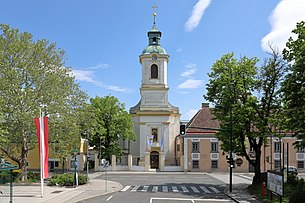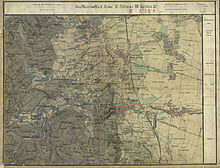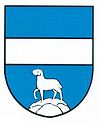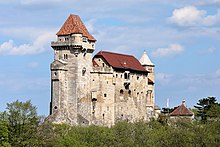Maria Enzersdorf
|
market community Maria Enzersdorf
|
||
|---|---|---|
| coat of arms | Austria map | |
|
|
||
| Basic data | ||
| Country: | Austria | |
| State : | Lower Austria | |
| Political District : | Mödling | |
| License plate : | MD | |
| Surface: | 5.27 km² | |
| Coordinates : | 48 ° 6 ' N , 16 ° 17' E | |
| Height : | 225 m above sea level A. | |
| Residents : | 8,624 (January 1, 2020) | |
| Population density : | 1636 inhabitants per km² | |
| Postal code : | 2344 | |
| Area code : | 02236 | |
| Community code : | 3 17 16 | |
| NUTS region | AT127 | |
| UN / LOCODE | TO BREATHE | |
| Address of the municipal administration: |
Hauptstrasse 37 2344 Maria Enzersdorf |
|
| Website: | ||
| politics | ||
| Mayor : | Johann Zeiner ( ÖVP ) | |
|
Municipal Council : ( 2020 ) (33 members) |
||
| Location of Maria Enzersdorf in the Mödling district | ||
 Parish and pilgrimage church of St. Magdalena in the center of Maria Enzersdorf |
||
| Source: Municipal data from Statistics Austria | ||
Maria Enzersdorf is a market town with 8,624 inhabitants (as of January 1, 2020) on the Thermenlinie in the Lower Austrian industrial district . Until 1999 the community was called Maria Enzersdorf am Gebirge .
Community structure
Maria Enzersdorf consists of the old town, hence the grown Maria Enzersdorf, and the southern town . While the old town lies in the western part of the municipality on the slope of the Vienna Woods , the southern part of the town was laid out east of it in the flat part of the Vienna Basin . The Südstadt was conceived as a planned residential and business area as a "garden city". The architects Wilhelm Hubatsch , Franz Kiener and Gustav Peichl commissioned by the Lower Austrian regional companies NEWAG and NIOGAS (today EVN) were responsible for planning the new administrative center of the above-mentioned company. Companies as well as the residential and business area connected to them. The groundbreaking ceremony took place on September 12, 1960.
Neighboring communities
| Giesshübl | Brunn am Gebirge | |
| Hinterbrühl |

|
|
| Mödling | Wiener Neudorf |
history
The history of the place is closely linked to viticulture . According to excavation finds, the Celts and the Romans are likely to have settled here.
From the 11th century on, there was a small wooden castle on a mound of earth on the Großer Rauchkogel, about 600 meters to the northwest and 20 meters higher than today's facility. This hill was enclosed by a wall and a moat. After 1100 the facility was expanded by the "Lords of Engilschalchesdorf" (today: Maria Enzersdorf).
The place was first mentioned in a document around 1130 as "Engelschalkesdorf" in Klosterneuburg Abbey . It was the time when Liechtenstein Castle was also built. The oldest church in the city was the chapel of Maria Magdalena (today Hauptstrasse 24/26), which in turn was built on the foundations of a medieval grangie of the monks of the Heiligenkreuz Abbey . In 1402 the Heiligenkreuzer Gutshof was sold to the community; it served her as the town hall until 1863 . In 1454 the Franciscan monastery was built. The place was destroyed several times in the course of the Turkish wars . The Franciscans also had to leave the monastery during the Reformation , but came back again, and Maria Enzersdorf was re-Catholicized. 1676–1678 Heiligenkreuz built the New Heiligenkreuzerhof in Mariazeller Gasse 5; it was owned by the monastery until 1918.

The history of the 19th century is very closely linked to Johann I von Liechtenstein , who bought Liechtenstein Castle back and reforested the forests around the town.
Late 19th century a second monastery, which was built mission house St. Gabriel of the Divine Word Missionaries . It is also thanks to this monastery that the surrounding area - despite the enormous construction pressure in the entire community - still includes some, partly overgrown green areas, for example dry grass with its high ecological importance.
From 1938 to 1954 Maria Enzersdorf belonged to Greater Vienna (24th district).
In 1964 a third monastery, the Poor Clare Monastery , was built.
The place underwent its greatest expansion when the Südstadt , which is designed as a garden city , began in 1961 under the former NEWAG General Director and Deputy Governor Viktor Müllner (the groundbreaking ceremony took place on September 12, 1960) and was completed in the 1970s. The construction of the Südstadt also doubled the population in ten years (1961: 3825, 1971: 8120). At the same time, the headquarters of today's EVN was built in the southern part of the city. The federal sports center Südstadt was also located here as part of the construction of the Südstadt.
On October 19, 2004, the decision was made to sell the old municipal office, which was too small and had security deficiencies, and to build a new municipal office on a property acquired in 2000. The existing Kielmannsegg-Schlössl was extended by a modern extension. The new address of the municipal administration has been Hauptstrasse 37 since August 6, 2007. The building was heavily criticized by non-party activists among other things because of its high, steadily rising costs and its oversized size. The ÖVP countered this by stating that these cost increases were precisely due to the years of delays caused by the active members.
The new municipal office was officially opened on October 6, 2007 in the presence of Lower Austrian Governor Erwin Pröll .
In the westernmost and highest part of the village (on the border with the municipality of Gießhübl ) there are gypsum sticks underground , where gypsum was mined until 1880. This mine was abandoned without any safety measures. In the 1990s, there were occasional subsidence on the surface, which could result from natural cavities created by subrosion , but also from former tunnels , as can still be seen in the neighboring Seegrotte . That is why more than 70 exploratory boreholes were carried out in 2004 and 2005, and old tools could be identified through video images from the depths in a tunnel . The tunnels extend to the neighboring municipality of Gießhübl. This is where the original entrance to the mine should be. Since the area was rededicated to building land in the 1970s , there are now residential buildings, some of which are already showing damage that could be attributed to earlier mining . However, since there was also a landfill in this area in the interwar period , damage could also result from insufficient soil compaction . The community of Maria Enzersdorf has pre-financed the costs for the exploratory drilling. The securing of the old mine, which began in early 2007 by filling the cavities, was completed in late August 2007. The federal, state and municipal authorities each contributed a third to the costs (estimated at 3 million euros) for this renovation.
Population development
| census | Residents |
|---|---|
| 2011 | 8,718 |
| 2001 | 8,202 |
| 1991 | 8,594 |
| 1981 | 9,148 |
| 1971 | 8,120 |
| 1961 | 3,825 |
Source: Population development of Maria Enzersdorf. (PDF) Statistics Austria
Culture and sights
- Parish and pilgrimage church of Maria, Heil der Kranken - no more parish church, just a pilgrimage church. Parish church is the church in the district of Südstadt
- Franciscan monastery Maria Enzersdorf
- Liechtenstein Castle : first mentioned in a document in 1136; built on a rock ridge at 300 m above sea level. Former headquarters of the Prince of Liechtenstein
- Liechtenstein Castle
- Mission House St. Gabriel
- Castle in the pasture
- Hunyadi Castle : late baroque castle
- Föhrenberge Nature Park
- Rauchkogel cultural landscape
- New Year's Concert: Every year since 1995 - usually on Epiphany or the last Sunday of the Christmas holidays - a New Year's concert with the Koncz ensemble has been held.
- Portiuncula Market : Every year on August 2nd, the traditional Portiuncula Market takes place in Kirchenstrasse and Franz-Keim-Gasse.
- Nestroy Games Liechtenstein : Until 2012, under the direction of Elfriede Ott, theater performances took place in the context of the Lower Austria Theater Festival, the so-called Nestroy Games at Liechtenstein Castle - in the courtyard on the outside of the castle.
- Boys 'Choir from the Vienna Woods Home of the choir school of the Vienna Woods Boys' Choir
- Choir Association Maria Enzersdorf
- Youth brass music Maria Enzersdorf
- EVN Collection (art collection)
politics
In the municipal council , the distribution of the 33 mandates has been since the 2020 municipal council election : List ÖVP 15, non-party active 7, List Die Grünen 6, NEOS 2, SPÖ 2, FPÖ 1.
- mayor
- 1849–1856 Josef Keck
- 1856–1864 Anton Kraus
- 1864–1867 Georg Sternecker
- 1867–1870 Franz Moser
- 1870–1873 Alois Hößl
- 1873–1876 Lambert Stix
- 1876–1900 Josef Leeb
- 1900–1913 Michael Hof
- 1913-1919 Franz Hof
- 1919–1921 Ferdinand Maller
- 1921–1938 Karl Huber
- 1938–1939 Josef Feistauer
- Mayor
- 1945–1947 Friedrich Paast
- 1947–1950 Josef Jaschek
- 1950–1954 Walter Modl
- mayor
- 1954–1965 Walter Modl
- 1965–1967 Gert Stanek
- 1967–1982 Peter Messinger
- 1982–1985 Franz Reith
- 1985–2000 Gottfried Höller
- 2000-2006 Christian Beck
- 2006–2013 Edeltraud Obner
- since 2013 Johann Zeiner (ÖVP)
Town twinning
-
 Bergschenhoek ( Netherlands ) 1976 to 2006. Due to the amalgamation of the Bergschenhoek municipality with the surrounding municipalities, the partnership was terminated after 30 years, as a partnership only makes sense between municipalities of roughly the same size.
Bergschenhoek ( Netherlands ) 1976 to 2006. Due to the amalgamation of the Bergschenhoek municipality with the surrounding municipalities, the partnership was terminated after 30 years, as a partnership only makes sense between municipalities of roughly the same size.
traffic
- Railway: The southern railway runs through the local area . The Brunn / Maria Enzersdorf train station is shared with the neighboring municipality of Brunn am Gebirge. It is located in the municipality of Brunn am Gebirge, north of Maria Enzersdorf. This means that Maria Enzersdorf is connected to Vienna every 15 minutes.
- The district of Südstadt is located directly on the Badner Bahn , which runs every 7–8 minutes in the direction of Wiener Neudorf and Wien- Oper during rush hour . The stop is just outside the municipality in the municipality of Wiener Neudorf (east of the municipality).
- The tram line 360 ( Vienna-Rodaun - Mödling ) also ran through the town until 1967 . It was replaced by a bus line.
- Bus: There are also a large number of bus routes running through the town, which guarantee good connections to Mödling and Siebenhirten ( U6 ), among other things . The Liesing train station , the Shopping City Süd and the Hietzing underground station ( line U4 ) can also be reached in a reasonable time.
- Road: Supraregional road connections are not directly in town, but the A2 Südautobahn and Vienna's outer ring Autobahn A21 can be reached quickly. The state road B12 (main road) runs through the village in a north-south direction and a few other state roads (In den Schnablern, Franz-Josef-Straße, Johannesstraße, Urlauberkreuzstraße) in an east-west direction. In recent years, as in the entire district, there has been an increasing volume of traffic, which, in addition to the above-mentioned traffic routes, also affected some side streets of the subordinate road network (Heugasse / Gabrielerstraße, Gießhüblerstraße / Franz-Keim-Gasse) disproportionately.
economy
- The original main occupation was viticulture, now trade and commerce are decisive. A large industrial company belonging to the global printing press manufacturer KBA is also located in Maria Enzersdorf. The headquarters of EVN , the energy supply company for Lower Austria (formerly Newag-Niogas), is in the southern part of the city . The two mentioned and the Stipschitz (VW-Audi) dealership are the largest companies in Maria Enzersdorf.
- The two most important centers of trade, Hauptstraße and the Südstadt shopping center, have been struggling with problems for years: There are hardly any new settlements in the Südstadt shopping center, mainly due to the strong competition from the Shopping City Süd, which is only a few kilometers away, and because of the relatively high rents. In the old town, the few shops have a hard time with few parking spaces, an unattractive ambience and the closure of the last supermarket (which has moved to a very large property only a few hundred meters away). Here, too, is the proximity of the district capital Mödling and shopping City Süd a shortcoming.
- Biomass cogeneration plant Mödling : In the densely built-up area, Maria Enzersdorf is almost completely open to biogenic district heating, which is generated in the biomass cogeneration plant in Mödling. The public buildings such as schools and administration buildings as well as the large-volume residential buildings are supplied with this district heating.
education
- 3 elementary schools (Altort, Südstadt and private elementary school SME)
- 1 high school (sports high school )
- 1 university (St. Gabriel Theological University in the St. Gabriel Mission House)
Up until the 2007/2008 school year there was also a secondary school in Maria Enzersdorf. Due to the low number of pupils, this school was merged with the secondary school in Brunn am Gebirge. The school is located in Brunn am Gebirge. At the site of the former secondary school, an extension of the elementary school, a new after-school care center and a kindergarten were built. The center was opened in 2011.
Sports
The Federal sports center is known with the former as Federal stadium Suedstadt designated NSRC-Arena , home of the football club FC Admira Wacker Mödling , the Austrian in the highest Football League, the league plays. Maria Enzersdorf is also the home of the nationally and internationally successful women's handball club Hypo Niederösterreich . Well-known individual athletes are, for example, the sports sailor Wolfgang Moser , triathlete Michael Weiss or the badminton player Katrin Neudolt .
Personalities
- Ilona Duczyńska (1897–1978), resistance fighter, journalist, translator and historian
- Elfie Mayerhofer (1917–1992), singer and film actress
- Viktor Müllner (1902–1988), Deputy Governor; Honorary citizen of Maria Enzersdorf
- Elfriede Ott (1925–2019), actress, singer and director; Honorary citizen of Maria Enzersdorf
- Hans Weigel (1908–1991), writer and theater critic
literature
- Silvia Petrin: Story of Maria Enzersdorf . 1979, self-published by the municipality of Maria Enzersdorf
Web links
- Market town of Maria Enzersdorf
- Entry on Maria Enzersdorf in the database of the state's memory for the history of the state of Lower Austria ( Museum Niederösterreich )
- 31716 - Maria Enzersdorf. Community data, Statistics Austria .
- Maria Enzersdorf in old postcards
Individual evidence
- ↑ Change of the community name mariaenzersdorf.gv.at, accessed on April 1, 2009. No longer available on January 13, 2019.
- ↑ The community in the Weinviertel has a different name orf.at, January 12, 2019, accessed January 13, 2019.
- ↑ Entry about Maria Enzersdorf on Burgen-Austria (accessed on July 11, 2019)
- ^ Hermann Watzl , Heiligenkreuzer Miszellen, in: "... In loco, qui nunc ad Sanctam Crucem vocatur ...". Sources and treatises on the history of the Heiligenkreuz Abbey (Heiligenkreuz 1987), pp. 172–203.
- ↑ Results of the municipal council election 2020 in Maria Enzersdorf. Office of the Lower Austrian state government, January 26, 2020, accessed on February 9, 2020 .
- ↑ a b c d The mayors of Maria Enzersdorf . Retrieved April 6, 2018.
- ↑ Then the 360 was finally dead ... In: Arbeiter-Zeitung . Vienna December 2, 1967, p. 7 ( berufer-zeitung.at - the open online archive - digitized).
- ↑ Homepage of the community ( Memento of the original from November 17, 2005 in the Internet Archive ) Info: The archive link was inserted automatically and has not yet been checked. Please check the original and archive link according to the instructions and then remove this notice.
- ↑ Our school on the website of the Maria Enzersdorf elementary school accessed on April 15, 2017
- ↑ a b honorary citizen of the market town of Maria Enzersdorf . Retrieved April 6, 2018.






